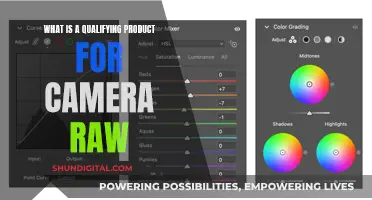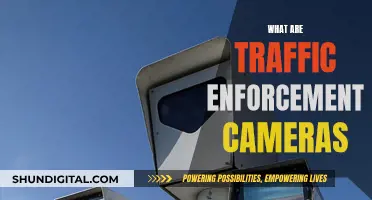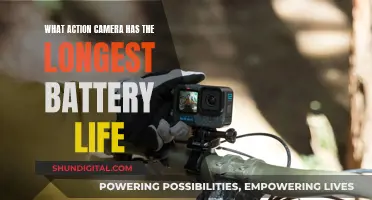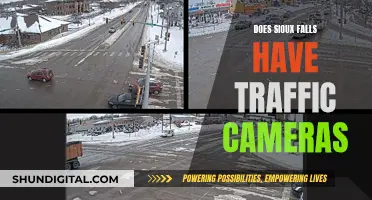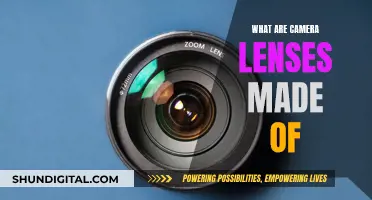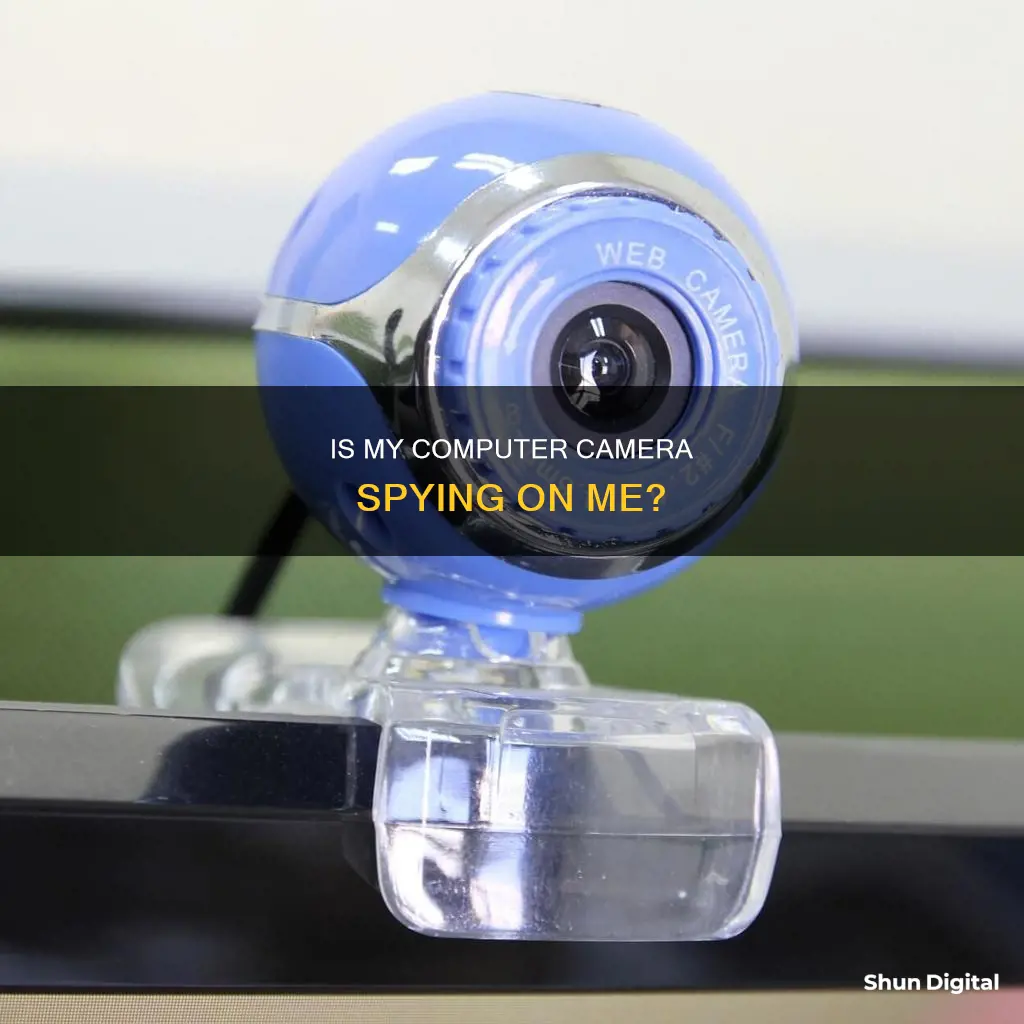
In today's tech-driven world, it is easy to feel paranoid about our privacy being compromised. With the rise of video chatting and social media live streaming, concerns about webcam security have never been more relevant. While it may seem far-fetched, the possibility of being watched through your computer camera is a legitimate concern. From hackers to government surveillance, there are various ways our webcams can be accessed without our knowledge, leading to a serious breach of privacy. So, how can we know if someone is watching us through our computer cameras, and what can we do to protect ourselves?
What You'll Learn

Can I prevent this by taping over my camera?
Taping over your webcam is a common practice to prevent hacking. Even Facebook CEO Mark Zuckerberg and former FBI Director James Comey have been reported to cover their webcams with tape. While it may seem paranoid, there have been numerous instances of webcams being hacked and used for spying and blackmail.
The indicator light on a webcam can be deactivated by hackers, so it is not a reliable way to determine if your camera is secure. Additionally, malware can be installed on your device without your knowledge, allowing hackers to access your camera and personal information.
Covering your webcam with tape is a simple and effective way to protect your privacy. However, it is important to note that tape can leave residue and potentially damage your camera lens or laptop screen. As an alternative, you can purchase webcam-blocking clips that give you the option to cover your camera when not in use.
While taping your webcam may not be the most aesthetically pleasing solution, it is a small price to pay for your privacy and security. It is a simple, low-cost method to prevent hacking and ensure your peace of mind.
The Evolution of Kodak Cameras: Materials and Design
You may want to see also

What is Zoom Bombing?
In the age of video chatting and social media live streaming, webcams have become an integral part of our lives. This also means that our privacy can be easily compromised. One of the ways in which this happens is through "Zoom Bombing".
Zoom Bombing refers to the unwanted and disruptive intrusion of internet trolls and hackers into a Zoom video conference or meeting. In a typical Zoom bombing incident, the teleconferencing session is hijacked by the insertion of materials that are lewd, obscene, racist, or anti-Semitic in nature, often leading to the shutdown of the session. Zoom raiders often employ shocking imagery, racial slurs, and profanity to derail video conferences.
To prevent Zoom Bombing, there are several security measures that can be implemented:
- Do not publicly share meeting links or IDs on open platforms like Facebook or Twitter. Share them only with the intended participants.
- Utilize the Zoom Waiting Room feature, which allows hosts to control when participants can join a meeting.
- Secure your meetings with a unique password. When participants join, they will need both the meeting link/ID and the password.
- Ensure that only the host can share their screen to prevent hijacking.
- Lock your meeting once all expected participants have joined to prevent unauthorized individuals from entering.
- Require participant authentication by restricting participants to those logged into Zoom.
If a Zoom Bombing incident occurs, it is important to respond promptly. If you are the host, remove the disruptive participant(s) immediately. If you are not the host, contact the host or IT to remove the disruptive individual(s). It is also recommended to hit the record button, save the chat, and take screenshots as evidence of the incident.
Yi Home Camera: Does It Have a Battery?
You may want to see also

How can I tell if my camera is moving without my command?
If you suspect that your camera is moving without your command, there are several steps you can take to investigate and address the issue. Here are some detailed instructions to help you determine if your camera is being controlled by someone else:
- Check the camera indicator light: If the light is on or blinking even when you haven't turned on the webcam, it could indicate unauthorised use. However, it could also be due to another program or browser extension running in the background, so further investigation is needed.
- Reboot your computer and launch your browser: If the webcam light turns on as soon as you open the browser, the issue is likely related to a browser extension. You can identify the culprit by deactivating extensions one by one.
- Check applications: Launch each application one by one and observe if the webcam indicator light turns on. If it does, you've identified the source of the problem.
- Check your webcam process: Go to the Task Manager and look for running programs under the "Processes" tab. If you see webcam utility running, don't panic yet as it may be a default setting. Restart your computer and check if the webcam utility starts automatically.
- Try running the webcam: Close all programs and apps and then try to activate your webcam. If you receive an error message stating that your camera is already in use, it could indicate a potential security breach.
- Check for audio and video recordings: Check the folder where your webcam stores recordings. Look for any unfamiliar or unexpected audio or video files. Also, check your webcam settings to ensure the storage folder hasn't been changed without your knowledge.
- Run a malware scan: If you suspect an unknown program is using your camera, perform a full system malware scan. If any malware is detected, move the file to quarantine and seek technical assistance if needed.
- Cover your webcam: As a precautionary measure, cover your webcam with tape or a sliding cover when not in use. This simple step ensures that even if someone gains access to your camera, they cannot see anything.
By following these steps, you can enhance your computer camera security and take control of your device. Remember, it's always better to have a proactive attitude towards cybersecurity and take preventive measures to protect your privacy.
Trail Camera Battery Life: How Long Do They Last?
You may want to see also

What are strange storage files?
It's a scary thought, but it is possible for someone to watch you through your computer camera. In 2014, the FBI ran an operation that uncovered a large number of webcam hackers in more than 12 countries. These hackers used a program called Blackshades, which gave them access to photographs and other files on victims' computers, as well as control of their webcams.
If you're concerned about being watched, there are a few signs that your webcam may have been compromised. One of these signs is the appearance of strange storage files. After a hacker records footage through your webcam, the video or audio files will be saved among your existing storage files. This means that if a file appears out of nowhere, it could be a red flag. Be vigilant about checking for files you didn't create, especially in folders related to your webcam recordings.
Strange storage files can take various forms. In some cases, they may be text files with cryptic messages. For example, a Reddit user reported finding a file titled "Hello.txt" in their downloads folder, which contained only the word "Hello." After deleting the file, it reappeared on their desktop with a new message: "I know you can see this." The user also discovered a folder filled with copies of the same text file, each containing the message, "Do you see me now?"
In other instances, strange storage files may be in the form of folders with unusual names or files with unrecognizable formats. For instance, a user on a Windows forum reported finding strange folders with names like "5db04cf14f3b47380c566badabf6" and "5af882f694e1714bffb8c1." Another user on a similar forum mentioned discovering files with names such as "4179" and "8932," with no apparent indication of their origin.
If you encounter strange storage files, it's essential to remain cautious and vigilant. While there may be benign explanations, it's important to consider the possibility of unauthorized access or malware. Running antivirus software and checking your system for any recently installed applications or programs can be a good first step. Additionally, ensuring that your webcam is protected by a strong password and covering it when not in use can provide an extra layer of security.
Lumix GX85: Does It Have a Macro Mode?
You may want to see also

What is the Blackshades programme?
Blackshades is a malicious trojan horse or Remote Administration Tool (RAT) that allows hackers to control infected computers remotely. The malware targets computers using operating systems based on Microsoft Windows. According to US officials, over 500,000 computer systems in more than 100 countries have been infected worldwide with the software.
Blackshades infects computer systems when victims access a malicious webpage (sometimes downloading onto the victim's computer without their knowledge) or through external storage devices, such as USB flash drives. The software can be used to access and modify files, log keystrokes, access webcams, and download and execute files on the victim's computer. It can also be used to launch distributed denial-of-service (DDoS) attacks, using infected computers as robots to carry out attacks against targets.
Blackshades can be purchased and used by hackers with little experience or technical skill. It has been sold online for as little as $40 and has generated $350,000 in sales. In 2014, the FBI arrested hundreds of people in connection with Blackshades, including the software's developers and sellers.
To protect against Blackshades and other RAT malware, it is recommended to use malware protection software, keep antivirus protection up to date, and avoid installing suspicious links or software on your computer.
Updating Camera Raw: Plug-In Essentials
You may want to see also
Frequently asked questions
There are a few signs that may indicate that your computer camera has been compromised. These include:
- Abnormal behaviour of the camera, such as rotating or moving without your command.
- Abnormal behaviour of the indicator light, such as blinking or turning on without your prompt.
- Strange storage files appearing, especially in your webcam recordings folder.
- Background apps that you did not install running on your computer.
To protect yourself from being watched through your computer camera, you can take several precautions, including:
- Using a virtual private network (VPN) to keep hackers at bay.
- Covering up your computer camera when not in use with tape or a sticker.
- Ensuring your camera is protected by a strong password.
- Being cautious when downloading apps or clicking links, as malware can be installed on your device without your knowledge.
It is not paranoid to be concerned about the possibility of being watched through your computer camera. In today's tech-driven world, our privacy can be easily compromised. There have been numerous reports of webcam hacking, including the FBI's Blackshades operation in 2014, which gave users access to computer cameras and personal information. Additionally, companies like Amazon have been accused of eavesdropping on users through devices like Alexa to collect data for marketing purposes. Taking precautions to protect your privacy is prudent.
If someone gains unauthorized access to your webcam, they can spy on you and the people around you without your knowledge. They may also be able to access your personal information, such as files stored on your computer and your browsing history. This can lead to a serious privacy breach and potentially dire repercussions, depending on the value and quantity of data stolen. In some cases, criminals have used compromising footage obtained through webcam hacking to extort money from victims.


